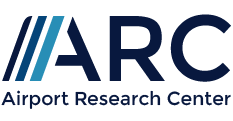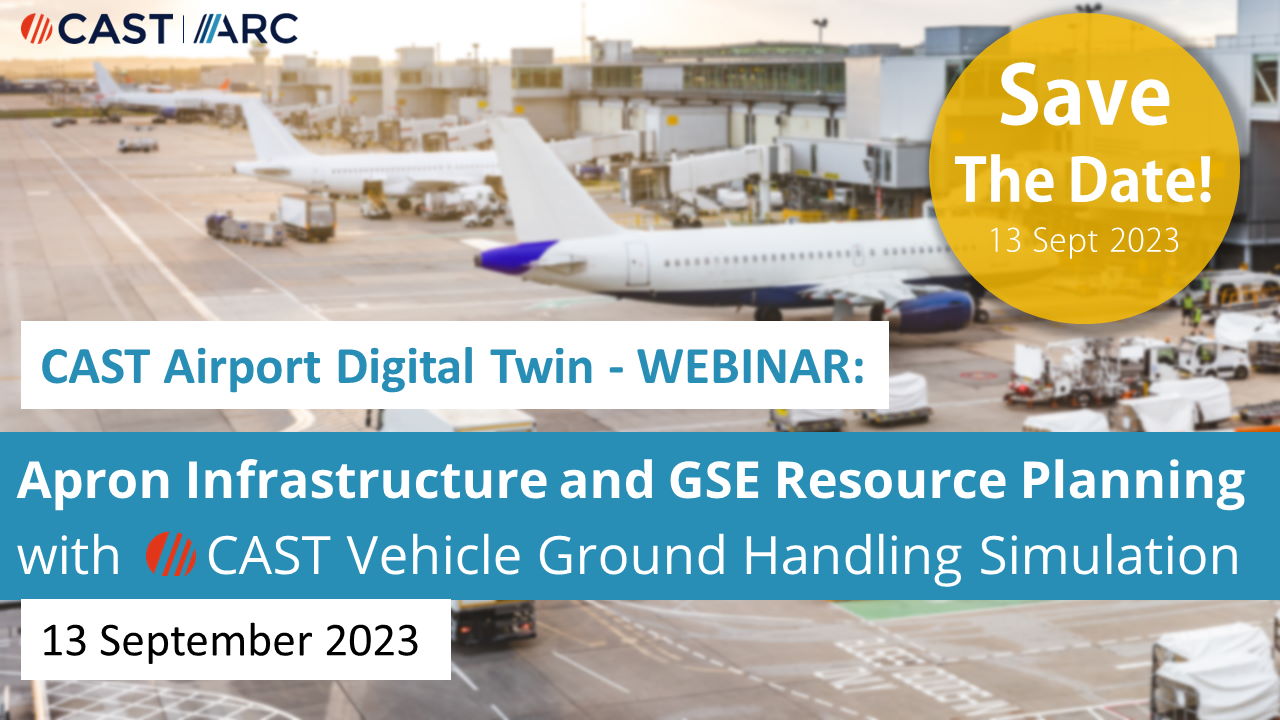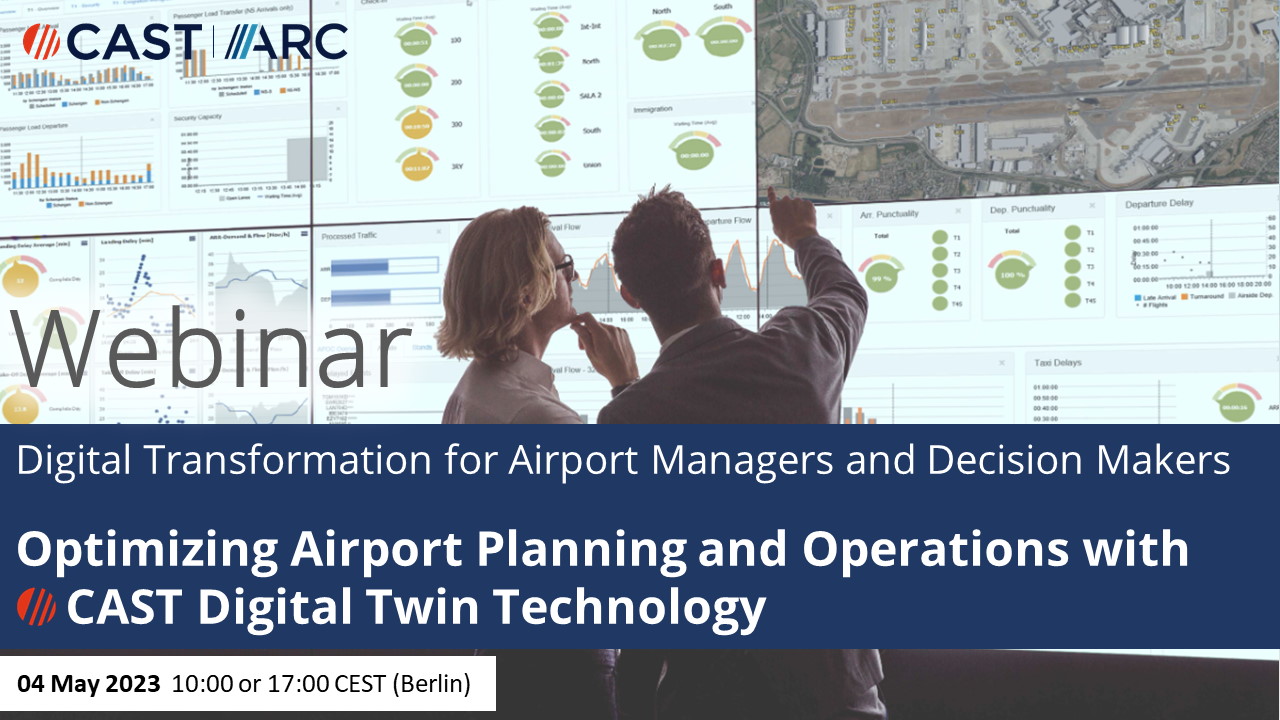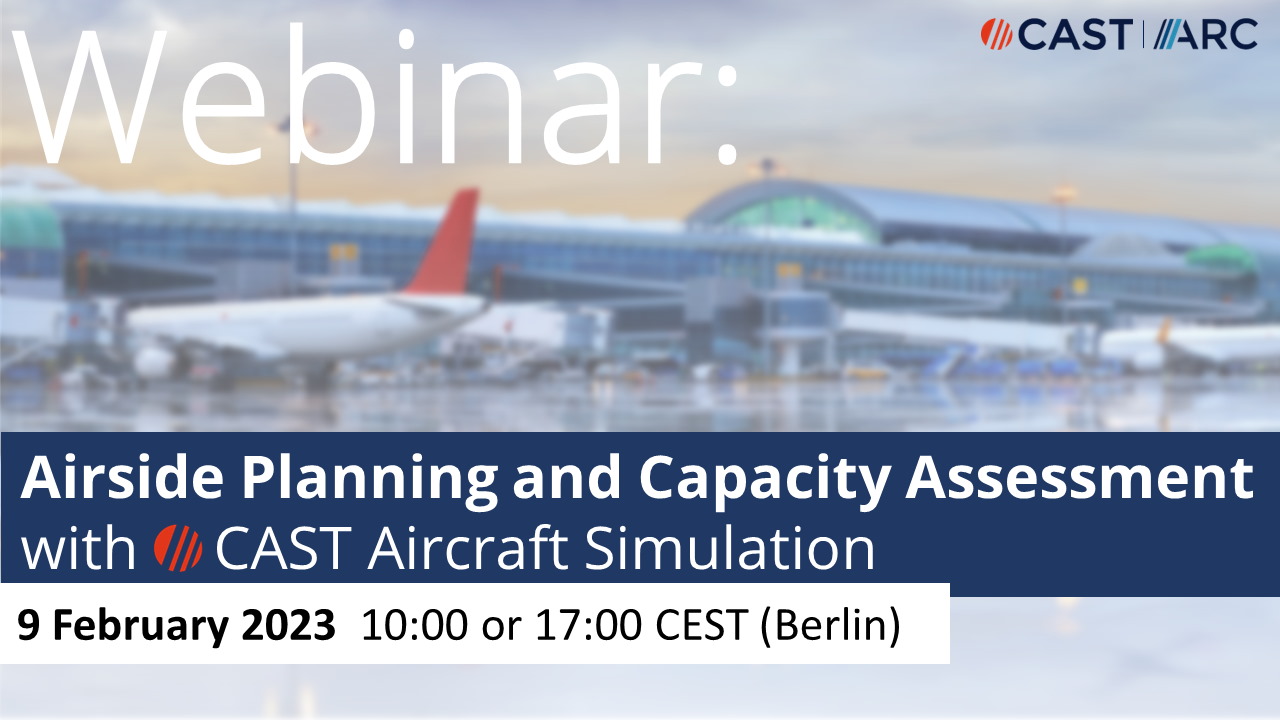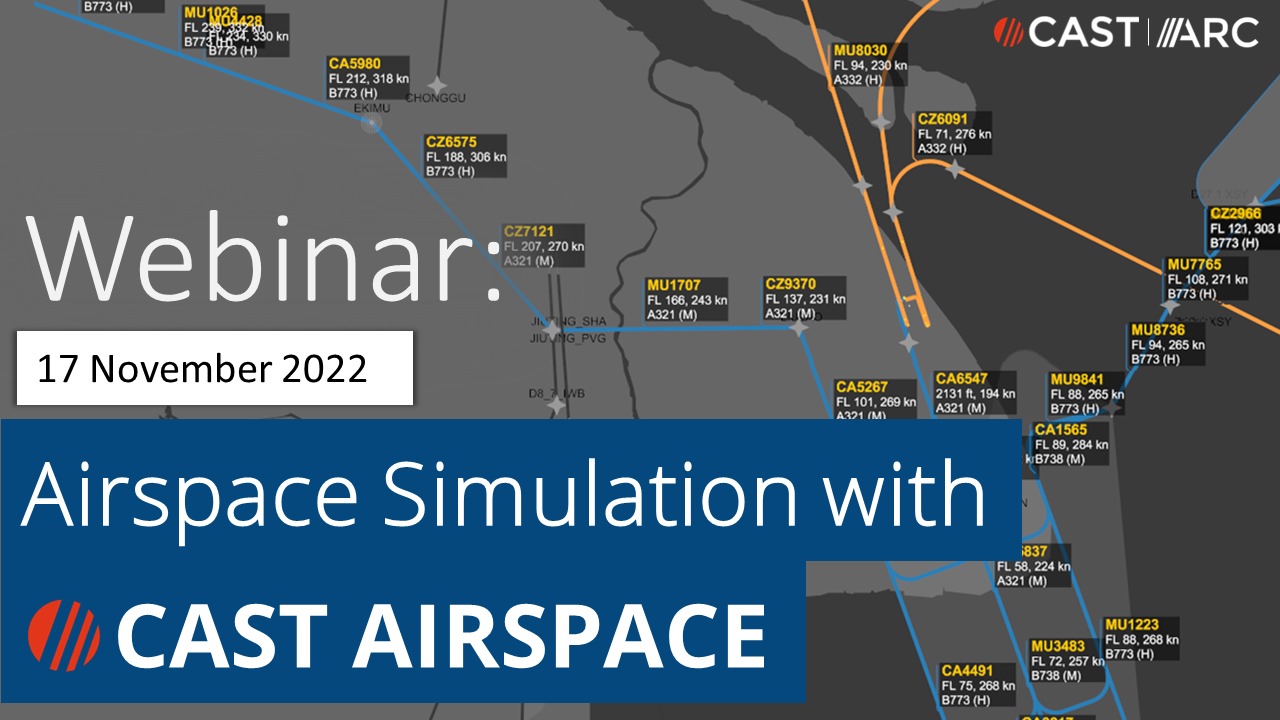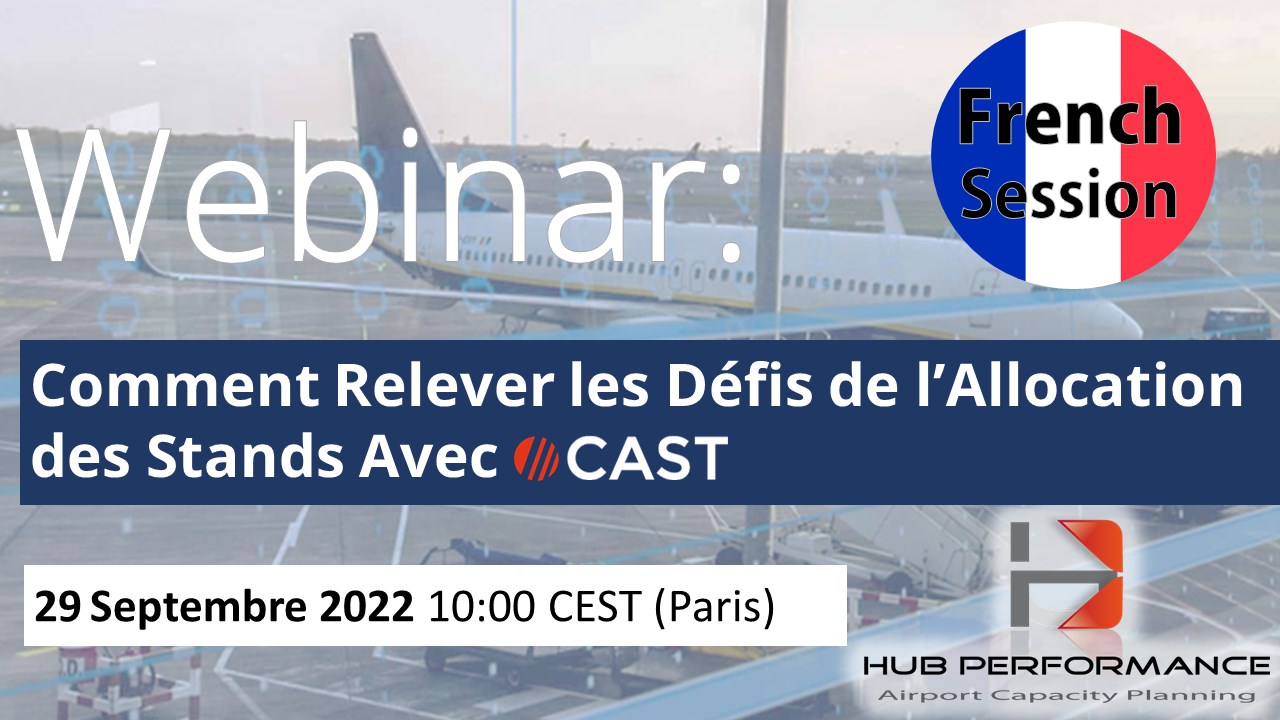Digital Transformation, Real-Time Flow Management, or Better Passenger Experience as well as Cost Optimization for Operations and Infrastructure Planning are up-to-date topics in the aviation industry. With its software products and services, ARC offers quick win measures as well as scalable options for digital support and solutions based on CAST technology.
With our webinar series, we would like to give you updates and more information about our products and present some success stories. These detailed demonstrations and workshops will show you how to benefit from the latest CAST highlights in your use cases, get technical questions answered and let us know your ideas and feedback.
In order to make the events best accessible for our international users, we are typically planning two time slots for each online event. It would be our pleasure to see you in one of the upcoming sessions. If you like to attend, please register here.
Past Webinars
A selection of past webinars can be found here. In case you are interested in one topic but have unfortunately missed it, please let us know. We can either send you a recording of the session or schedule an individual meeting.
CAST Pax Flow Prediction at Berlin Airport

We’re excited to invite you to an exclusive webinar where Berlin Brandenburg Airport shares its success story with the CAST Pax Flow Prediction — the leading platform for predictive passenger flow analysis and real-time resource management in airport terminals.
The airport team will share the background, their implementation and practical insights into how the system is used to support real-time passenger flow analysis, optimize resource planning, and improve operational performance.
Benefits:
- operational predictive analysis of passenger flows, terminal resources and airport processes across various time horizons.
- Proactive and reliable planning and resource management.
- Dashboards for operational teams of all relevant stakeholders
- Reduces waiting times and queues, while at the same time reducing staffing requirements and costs!
- Award-winning solution that has already improved journeys for hundreds of millions of passengers and the number is growing by the hour…
How to Meet Stand Allocation Challenges With CAST
Apron capacity constraints require a smart and flexible approach to release hidden capacity and optimize your infrastructure instead of running into unnecessary investments. CAST Stand & Gate Allocation is a powerful platform that allows you to derive insights and make informed decisions based on customizable allocation rules and what-if scenarios. The tool finds application in unlimited planning and operational tasks. It supports the assessment and comparison of different allocation strategies, the calculation of stand requirements for various time horizons, and the investigation of capacity bottlenecks and design of related mitigation measures.
This demonstration describes the workflow of an allocation model set-up, gives expert advice on how to leverage advanced CAST features to maximize efficiency, and shows the connection between the allocation model and the integrated analysis for extracting valuable KPIs.
Apron Infrastructure and GSE Resource Planning
with CAST Vehicle Ground Handling Simulation
Strategic, tactical, and pre-operational airport planning benefit from a smart approach to optimize infrastructure, prevent unnecessary investments, and fine-tune operations. CAST Vehicle Ground Handling Simulation is the unique simulation tool to derive insights and make informed decisions based on scenario analyses for the ground handling operations at an airport.
CAST Vehicle finds application in unlimited tasks. It facilitates the assessment and planning of vehicle and ground handling infrastructure, determines the ground handling resource demand, compares different operational strategies, and finds mitigation measures in case of bottlenecks.
In this 1-hour webinar, based on the experience of various airside projects worldwide, our experts will give examples for the wide scope of use-cases and the respective benefits, show how CAST’s integrated analysis is used for highly efficient analysis and result generation how easy and quick the rollout of CAST Vehicle could be done.
Airport Terminal Capacity Planning with CAST Simulations
Apart from planning new terminal buildings, the evaluation and improvement of existing airport terminals and their facilities are essential planning objectives. A smart analysis of airport operations by means of simulation, often leads to the detection of unused reserves, ideas for quick wins and the postponement or even prevention of cost-intensive expansion issues.
CAST Terminal and CAST Express provide a powerful simulation environment to support strategic, tactical and operational planning.
In this 1-hour webinar our experts will give examples for the wide scope of use-cases and the respective benefits, show how CAST’s is used for highly efficient analysis and result generation and how easy and quick the rollout could be done.
Digital Transformation for Airport Managers and Decision Makers
Optimizing Airport Planning and Operations with CAST Digital Twin Technology
In this webinar, our experts will discuss how CAST Digital Twin technology can be applied to optimize short- and long-term airport infrastructure planning, airside and landside operations, enhance passenger experience, and reduce costs. We will explore how CAST can create a virtual representation of the whole airport system including its infrastructure and processes, enabling to predict the future, analyse and act informed and proactively to improve the systems performance and efficiency.
We will also cover how CAST’s Digital Twin technology can be used to support scenario evaluation and what-if tests before implementation, reducing risk and increasing efficiency.
SOLUTIONS powered by CAST Express
Simulation-based Real Time Demand Prediction for Better Airport Resource Planning
As part of the digital transformation, SOLUTIONS powered by CAST Express are customized software and services that provide real-time predictive analysis of airport terminal processes.
On the day of operation and utilizing IT data like AODB, RMSs or live process monitoring systems, the CAST Express technology provides highly precise predictions and passenger flow information, allowing better resource planning and proactive, agile management in order to reduce costs and waiting times.
Based on the stories of several successful implementations at airports like HKG, ICN, MUC, DUS or BER, the background, methodology and benefits will be described in this demonstration. Further we will explain the scalable ways of implementation from a quick start to a sustainable long-term road map.
Airside Planning and Capacity Assessment with CAST Aircraft
CAST Aircraft is the powerful simulation software that allows you to derive insights, balance demand and capacity and make informed decisions to reduce costs and improve operational quality.
Use cases cover the assessment and comparison of different operational strategies, planning of infrastructure requirements for various time horizons, investigation of capacity bottlenecks and related mitigation measures including quick wins.
In this 1-hour webinar, based on the experience of various airside projects worldwide, our experts will give examples for the wide scope of use-cases and the respective benefits and show how easy and quick the rollout of CAST Aircraft could be done for you.
Airport Challenges by the new European Entry/Exit System (EES)
Complying with the new European Entry/Exit System (EES) will become a new requirement for the European airports in the near future. The EES system will be an automated IT system registering travellers from third countries (i.e. NonEU nationals) each time an EU external border is crossed. The system will compare and/or register a set of data including the passenger’s biometric data, including fingerprints and facial images.
Although nuances of the final implementation still need to be finalized, airport operators and responsible agencies need to start planning for this new system and the related operational and technical challenges. This is of particular importance as previous studies by ARC pointed out that a ‘do-nothing’ strategy can easily push waiting times and queue lengths at immigration to inacceptable levels.
In this joint webinar with Munich Airport we demonstrate the impact on passenger handling and resource allocation, compare different operational principles for applying the EES rules and give recommendation how to prepare best for the new system.
From Airway to Touchdown – Airspace Simulation with CAST
Let’s get ready for lift-off! CAST has made the next step into air: Based on the proven CAST Aircraft platform, ARC’s new module CAST Airspace is widely extending your options in airspace capacity studies, new organization of routes or re-sectorization projects.
This demonstration describes the typical use cases of CAST Airspace like:
- Design of terminal maneuvering area (TMA)
- Optimization of SIDs, STARs and Holdings
- Ultimate and declared capacity studies
- Validation of ATC procedures and runway usage concepts
- Quantification of airspace operational and environmental performance (delays, fuel burn)
How to Meet Stand Allocation Challenges With CAST (French Version)
Apron capacity constraints require a smart and flexible approach to release hidden capacity and optimize your infrastructure instead of running into unnecessary investments. CAST Stand & Gate Allocation is a powerful platform that allows you to derive insights and make informed decisions based on customizable allocation rules and what-if scenarios. The tool finds application in unlimited planning and operational tasks. It supports the assessment and comparison of different allocation strategies, the calculation of stand requirements for various time horizons, and the investigation of capacity bottlenecks and design of related mitigation measures.
This demonstration describes the workflow of an allocation model set-up, gives expert advice on how to leverage advanced CAST features to maximize efficiency, and shows the connection between the allocation model and the integrated analysis for extracting valuable KPIs.
Big Data Driven Prediction to Optimize Aircraft Stand Allocation

Are you interested in the latest trends and research results on aircraft stand allocation optimization?
ARC and Amsterdam University of Applied Sciences with Zurich Airport as an industrial partner just completed the mFund project ‚A-Boost – Next Generation Allocation ‘. The goal of the project was to apply machine learning, optimization, and simulation techniques to improve the CAST Software for resource allocation at an airport to better deal with operational uncertainties.
Find more information about the background and scope of this research project here.
The results of this research project will be shown in an 1-hour online presentation on 20 June 2022 at 14:00 CEST.
Enhanced Flight Schedule Analysis
With new pre-designed flight schedule analysis templates, CAST allows an optimized planning of operations and to foresee potential new challenges. Analysis of a full flight schedule season, smart features regarding busy day ranking and selection while considering different traffic segments will support a better understanding of peak structures and traffic patterns leading to improved decision making.
Next to integrating enhanced analysis features to the existing CAST simulation tools, a stand-alone CAST Flight Schedule Analyzer is intended to support further airport planning questions: Use cases range from a smart selection of one or several representative peak periods for tactical planning, to a solution linked with the airport’s AODB to get dynamic demand forecasts for operations planning and to manage volatile flight schedules.
This session is designed as a workshop, where you can actively contribute to the discussion on most useful analysis features for the future CAST flight schedule analysis.
CAST Airspace
As an optional extension of CAST Aircraft, CAST Airspace significantly expands the possibilities of airspace capacity studies, airspace and route design or vectorization projects. CAST Airspace covers airspace routes including their SIDs, STARs and sectors for initial, intermediate and final approach. ATC concepts such as radar vectoring, speed control and holding procedures are incorporated and can easily be applied and tweaked by the user. Detailed flight profiles are realized by the application of the Eurocontrol BADA performance database, ensuring realistic three-dimensional aircraft performance for all common aircraft types.
This session focuses on an in-depth demonstration of a typical Airspace model, explains which use cases and KPIs are possible and how your studies can benefit from the new tool. In a Q&A session we are looking forward to learn about your demand for airspace modelling and get your feedback.
